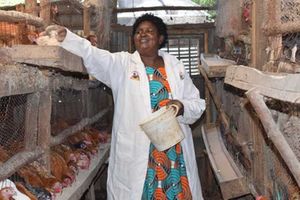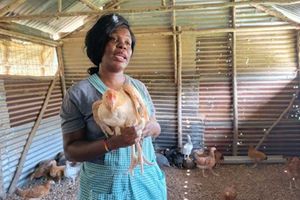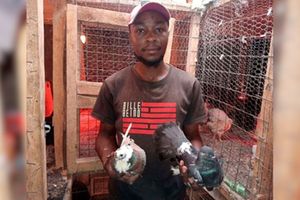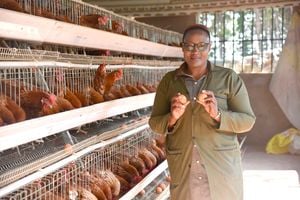
Kienyeji chicken in a coop.
Continuous laying of eggs by kienyeji hen
Is it possible for kienyeji chickens to lay eggs continuously like exotic birds? What do I need to do to achieve this? - Malloum Ngarta - Machakos
The market demand for pure indigenous chickens (IC) and their products remains high despite their falling numbers. Their eggs are nutritionally superior to those from commercial layers and improved kienyeji, making them highly sought-after.
However, the laying capability (number of eggs per year) of IC is low, attributed to genetic differences. IC usually start laying eggs around six months of age. The capability depends on various factors, including age, nutrition and environment.
These factors can be altered to attain a higher egg production efficiency. For instance, give the birds quality feed (including supplement feeding for free-rangers).
Pullets need feed with good protein content to aid in fast growth and development as well as to prepare them for laying. Selection helps to bring pullets into laying as early as possible, without forcing them.
Pullets that delay coming to lay are naturally poor layers and burn out quicker. They should be culled and replaced. Typically, a chicken lays an egg almost daily after the first laying.
This becomes shorter for indigenous chickens when they set in their natural/instinctive behaviour of broodiness – eventually contributing to declining egg production. They stop laying and sit on eggs till hatching. Broodiness does not occur in commercial layers as the trait has been selected.
Many farmers try to discourage broodiness unless they are interested in hatching eggs. One can draw preventive measures or develop quick-fix solutions for broodiness, including changing the environment of laying boxes, increasing light or continuously collecting laid eggs.
Additionally, provide access to calcium-rich feed sources at the time of laying. Always keep in mind the five freedoms of rearing animals.
Felix Akatch Opinya, Animal production adviser
Flower types and when to use them
Dear Seeds of Gold Crop Expert, what flowers are best for occasions like birthdays, weddings, anniversaries and even funerals? Advise too on flowers that are affordable to the majority and those that are pricey. Where in Nairobi, Nakuru, Kisumu or Mombasa can I get them? I intend to start an events business. The many people I’ve talked to don’t like the idea of plastic flowers. - Maureen Amagove, Nairobi
Roses, Gerbera daisies, lilies and tulips are ideal for birthdays. Orchids and hydrangeas are also good. Flowers used in weddings include roses, peonies, gydrangeas and orchids. For anniversaries, most people prefer red roses, carnations, orchids and lilies. Lilies, chrysanthemums, roses, carnations and gladiolus are okay for funerals.
Arrangement can include a variety of flowers, depending on the occasion, design and colour theme. The main flowers include roses, carnations, lilies, peonies and orchids.
You will need fillers to add volume and texture. Fillers include baby’s breath (gypsophila), statice, silidago (goldenrod) and astilbe.
You will also need line flowers to add height and structure. Line flowers include gladiolus, snapdragons, delphiniums and lurkspurs.
Lastly, you will need greens and foliage to enhance the overall look. You can use fern leaves, ruscus, leatherleaf fern or Ivy.
Get in touch with flower farms in Naivasha, Nakuru and Nairobi and buy stock from them.
Carol Mutua - Crop Production Specialist
How to improve sandy soil capacity
Hello, you recently advised a Seeds of Gold reader on how to improve the productivity of clay soil. Could you also do the same for sandy soils? I have seven acres of sandy soil land in Kwale.- Abdul Rahman Swaleh
Sandy soils, generally, have low nutrients and low water holding capacity. They can be improved by adding organic matter. This improves the soil structure and water holding capacity.
Compost and farmyard are the best organic manure to use to improve sandy soil. Mulching can also help maintain soil moisture by reducing the rate of evaporation and wind erosion.
You can also use peat moss or cocopeat to improve the water-holding capacity of the soil.
Bichar can be used to improve water-holding capacity, enhance nutrient availability and promote beneficial microbial activity.
Carol Mutua - Crop Production Specialist
Farmers advised to embrace vaccines
There has been hue and cry over the looming vaccination of domestic animals. What is the problem, for I am a believer in vaccines? Why should such a noble cause generate a storm? What is the view of animal health providers on this matter? I have around 70 sheep and goats, 12 cows and many chickens.- Buku Noel, Tana River
Vaccination is an important part of livestock health. The government is expected to facilitate a nationwide livestock vaccination targeting about 22 million animals across all counties from this month.
The exercise aims to combat certain notifiable diseases and promote sustainability of the livestock industry.
Ideally, implementation of a successful vaccination drive depends on three main factors – the animal, personnel (expertise or skills) and the vaccine.
The Directorate of Veterinary Services (DVS) under the law has the mandate to conduct quality assurance of the vaccines, in order to protect livestock health and by extension farmers.
As a matter of fact, the head of the authority reiterated that the campaign would rely on vaccines manufactured by the Kenya Veterinary Vaccines Production Institute (KEVEVAPI), a state corporation under the Ministry of Agriculture and Livestock Development.
KEVEVAPI has in place systems where the vaccines are tested locally and externally by the African Union Pan African Veterinary Vaccine Centre (AU-PANVAC). It has found the vaccines to be fit for use.
To enhance uptake and expand reach to livestock, it is important that farmers are continually sensitised on the programme, more especially through county governments.
Until this point, it is important that livestock keepers remain calm as the government plans on the program/activity – and in turn give more directives.
Felix Akatch Opinya - Livestock Production adviser










